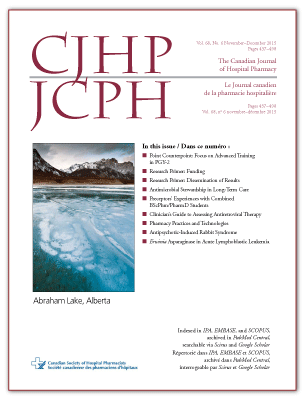Survey of Pharmacy Preceptors’ Expectations and Experiences with Students on Rotations in an Inaugural Combined BScPhm/PharmD Class
DOI:
https://doi.org/10.4212/cjhp.v68i6.1501Keywords:
pharmacy, preceptors, students, expectations, practical experience, pharmacie, précepteurs, étudiants, attentes, expérience pratiqueAbstract
ABSTRACT
Background: In September 2011, the Leslie Dan Faculty of Pharmacy, University of Toronto, Toronto, Ontario, began offering a combined BScPhm/PharmD program to third-year students and postbaccalaureate graduates. Learning consisted of in-class teaching and Advanced Pharmacy Practice Experience (APPE) rotations.
Objective: To explore preceptors’ expectations and perceptions of student performance in the APPE rotations of the new combined degree program.
Methods: A survey was distributed via email to 132 pharmacists from the Toronto Academic Health Science Network who had acted as preceptors for the combined degree program in academic year 2011/2012. The 17 questions were designed to gather information on preceptors’ demographic characteristics and their expectations and evaluations of the combined-program students. Responses were analyzed qualitatively for common themes and quantitatively using sums and means. Survey responses were compared to identify alignment and discrepancies between preceptors’ expectations and evaluations of students.
Results: The survey response rate was 48% (63/132). Most respondents (46 [73%]) were from a teaching hospital, and the same proportion (46 [73%]) reported being preceptors for a direct patient care rotation. Forty-four (70%) of the respondents expected students to be at the level of traditional PharmD students, hospital residents, or advanced-level Structured Practical Experience Program students, and 35 (80%) of these 44 respondents reported that their students met or exceeded expectations. According to survey responses, 31% of respondents (18/58) ranked students at the corresponding level of performance on the faculty’s assessment form, while 62% (36/58) ranked students at a higher level (5 respondents did not complete the question). Only one-third of respondents felt that they personally had received adequate training before taking on preceptor duties for combined-program students.
Conclusions: Preceptors’ perceptions of the rotation and their expectations of students varied widely and were influenced by prior teaching and learning experiences. There was a disconnect between preceptor-specific expectations and preceptors’ final evaluations of students. Training to standardize the expected level of performance and additional training for preceptors would further enhance the APPE rotations of the combined degree program.
RÉSUMÉ
Contexte : En septembre 2011, la Faculté de pharmacie Leslie Dan de l’Université de Toronto à Toronto, en Ontario, a commencé à offrir un programme de double diplôme, B. Sc. Phm.–Pharm. D., aux étudiants de troisième année et aux diplômés titulaires d’un baccalauréat. Le programme reposait d’une part sur un enseignement en classe et d’autre part sur des stages offrant une expérience pratique avancée de la pharmacie (Advanced Pharmacy Practice Experience [APPE]).
Objectif : Étudier les attentes des précepteurs envers la performance des étudiants participant aux stages APPE du nouveau programme de double diplôme ainsi que la perception qu’ils en ont.
Méthodes : Un sondage a été envoyé par courriel à 132 pharmaciens oeuvrant dans le Toronto Academic Health Science Network et ayant agi à titre de précepteurs dans le programme de double diplôme durant l’année universitaire 2011-2012. Les 17 questions du sondage ont été conçues dans le but de recueillir des informations sur les caractéristiques démographiques des précepteurs ainsi que sur leurs attentes envers les étudiants et les évaluations qu’ils ont faites de ceux-ci dans le cadre du programme double. Les réponses ont été analysées qualitativement pour établir des thèmes communs ainsi que quantitativement à l’aide de sommes et de moyennes. Les réponses au sondage ont été comparées afin de relever des concordances et des divergences entre les attentes des précepteurs envers les étudiants et les évaluations qu’ils ont faites d’eux.
Résultats : Le taux de réponse au sondage était de 48 % (63/132). La majorité des répondants (46 [73 %]) travaillaient dans un hôpital universitaire et un même nombre de répondants (46 [73 %]) ont indiqué agir à titre de précepteurs pour un stage de soins directs aux patients. Quarante-quatre (70 %) des répondants s’attendaient à ce que les étudiants soient à la hauteur des étudiants du programme de Pharm. D. traditionnel, des résidents hospitaliers ou des étudiants de haut niveau dans le programme structuré d’expérience pratique (Structured Practical Experience Program) et 35 (80 %) de ces 44 répondants ont déclaré que leurs étudiants avaient satisfait aux attentes ou les avaient dépassées. Selon le sondage, 31 % des répondants (18/58) ont classé les étudiants au niveau de performance correspondant sur le formulaire d’évaluation de la faculté, tandis que 62 % (36/58) ont classé les étudiants à un niveau supérieur (cinq répondants ont négligé cette question). Seul le tiers des répondants estimaient avoir reçu une formation suffisante avant d’endosser le rôle de précepteur auprès des étudiants du programme de double diplôme.
Conclusions : Les perceptions des précepteurs envers le stage de même que leurs attentes envers les étudiants variaient grandement et étaient influencées par des expériences d’enseignement et d’apprentissage passées. Il y avait un écart entre les attentes des précepteurs et leurs évaluations finales des étudiants. Un enseignement visant à normaliser le niveau de performance attendu ainsi qu’une formation supplémentaire pour les précepteurs amélioreraient davantage les stages APPE du programme de double diplôme.
Downloads
Published
Issue
Section
License
Copyright © Canadian Society of Healthcare-Systems Pharmacy.
After publication of a manuscript in the CJHP, the authors of the manuscript must obtain written permission from the CSHP (publications@cshp.ca) before reproducing any text, figures, tables, or illustrations from the work in future works of their own. If a submitted manuscript is declined for publication in the CJHP, all said rights shall revert to the authors. Please note that any forms (e.g., preprinted orders and patient intake forms) used by a specific hospital or other health care facility and included as illustrative material with a manuscript are exempt from this copyright transfer. The CJHP will require a letter from the hospital or health care facility granting permission to publish the document(s).










